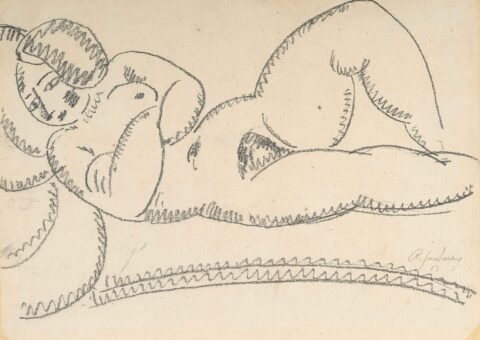
“Meditation (VI 1936 N. 8)”
Details
According to the Catalogue Raisonné by Lisa Kümmel, the artist’s assistant, inscribed on the back of the loose backing card “A. Jawlensky VI. 1936 N. 8.” Jawlensky/Pieroni-Jawlensky 1982. With a photo expertise by Maria Jawlensky, Alexej von Jawlensky Archiv, Locarno, dated 30.12.1988. Literature:Weiler, Clemens, Alexej of Jawlensky. Köpfe, Gesichter, Meditationen, Hanau 1970, no. 852, not ill.Exhibitions:Autumn 1986, Galerie Ludorff, Düsseldorf 1986, with col. illus. p. 59; Spring 1987, Galerie Ludorff, Düsseldorf 1987, cat. no.46, with col. illus. p. 69; Autumn 1989, Galerie Ludorff, Düsseldorf 1989, cat. no.54, with col. illus. p. 81. Provenance: The artist’s studio; collection of Dr. Hans Lühdorf (1910-1983), Düsseldorf, acquired as a gift from the artist; private collection, Düsseldorf; Lempertz, Cologne 31.5.1986, lot 468, col. plate 30; Galerie Ludorff, Düsseldorf; private collection, North Rhine-Westphalia.
Description
• Mystical, religious face with a fascinating aura
• The motif is reduced to its basic forms in a dark colour palette
• The “Meditations” are a highlight of Jawlensky’s oeuvre
“My last period is painted on very small formats, but these works are deeper and more spiritual, spoken only in colour.” Alexej von Jawlensky, 1936. In his “Meditations” series, Jawlensky stylises the human face almost to the point of abstraction. The small-format faces are reminiscent of icons, however they are not standardised, but rather individual works. The expressions of the faces appear withdrawn, the use of a primarily muted colour palette accentuates the meditative mood. Jawlensky constructs the face from just a few horizontal and one vertical line. In the work offered here from 1936, a light yellow shimmers through on the sides of the head and one side of the face is emphasised with delicate white brush strokes. This models the face and allows the head to emerge from the darkness and the surface of the picture. In 1934, Jawlensky began his last major and now famous series of mystical, religious “Meditations” in dark tones. The 1930s were an extremely difficult time for the 70-year-old artist. Following the National Socialist seizure of power in 1933, he was forced to retreat into private life. His works were confiscated in museums and defamed at the National Socialist propaganda exhibition “Degenerate Art”. He also suffered from severe paralysis in his hands and knee joints and his mobility was continually decreasing. However, neither the external circumstances nor his failing health could stop Jawlensky from painting. He developed his own method to be able to continue working despite the progressive stiffening of his fingers. He created motifs that were reduced to their essential elements using the simplest artistic means, painted in a small format on card or paper. He chose the two genres – portraits and flower still lifes – that had shaped his oeuvre in the previous years and was therefore able to create an astonishingly large number of small-format works until he became completely paralysed in 1938. Jawlensky gave this meditation to the Düsseldorf collector Dr. Hans Lühdorf. The lawyer Lühdorf discovered Expressionism – ironically – at the “Degenerate Art” exhibition in 1937 and then began collecting primarily Expressionist prints.
* All results incl. buyer’s premium (27%) without VAT. No guarantee, subject to error.
** All post-auction prices excl. buyer's premium and VAT. No guarantee, subject to error.
*** Conditional Sale: The bid was accepted below the limit. Acquisition of the work may still be possible in our post-auction sale.
R = regular taxation
N = differential taxation on works of art which originate from a country outside of the EU
The private or commercial use of images shown on this Website, in particular through duplication or dissemination, is not permitted. All rights reserved.



